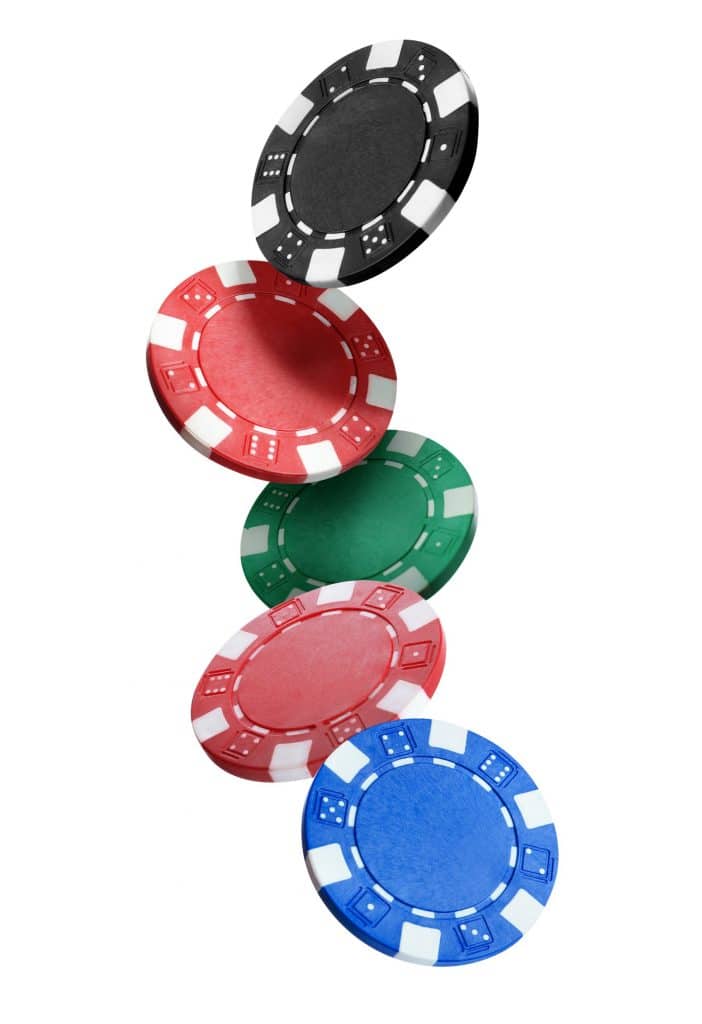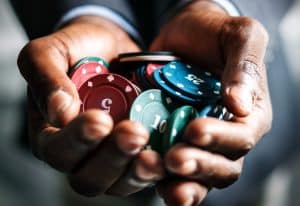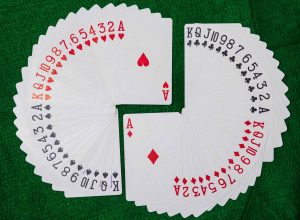While online and live poker is played by the same rules, there are several differences to consider when switching from online to live.
In this article, we’ll go over the differences between online poker and live poker, as well as five poker tips you can use to make the transition as easy as possible so you can start maximizing your earnings. So let’s dive into it and see important details.
ONLINE POKER VS LIVE POKER MAIN DIFFERENCES
Let us list a few distinctions between online poker and live poker:
- Tells: You can try to read a player’s mannerisms in real life. In online poker, your only options for reads are the player’s bet sizing and playing ranges.
- Speed: Online poker’s number of hands per hour is much higher than live poker.
- Calculations: In online poker, you have exact bet and stack sizes in front of you.
- Software: Online poker allows you to use software to calculate statistics on the players you are playing against. There is no such thing in real life.
- Number of Games: You can easily play multiple games online at the same time, but you don’t have that option with live poker.
Now that we listed the main distinctions let us see how to make the transition and beat your opponents on both grounds.
LOOK FOR SPOTS TO SHOW YOUR OPPOSITION’S POST-FLOP
Live games are much more forgiving than online games. Players you face will not have such solid fundamentals, and because they have less experience in terms of the volume of hands played in their lifetime, they are frequently unsure how to play their hand on later streets.
This allows you to profit from live players frequently’s huge mistakes. They are overly passive post-flop, which is a common trait. They will either miss obvious river value bets or get creative with their monster hands, allowing you to realize more equity and get to a showdown for less money.
You can get away with pushing some player types out of the pot with pure aggression. However, many live players aren’t accustomed to playing against aggressive opponents.
Conversely, a maniac or whale is much more likely to sit next to you at a live table than in an online game. Depending on the villain, betting thinner for value or potentially calling down lighter are two simple adjustments you can make to scoop up some nice pots.
All of these arguments favor playing more hands after the flop. So you can get the most out of the skill disparity between you and your opponents.
BE MUCH TIGHTER AGAINST AGGRESSION
Most games in casinos or at home will be driven by some looser recreational players. The stronger live players and regs usually wait for these looser players to feed on them and have developed a lot of patience to do so. But on the other hand, solid fundamentals are typically lacking in their development.
This brings us to the first of three common mistakes made by live players that we can exploit.
PLAY TIGHTER AGAINST 4-BETS
Unless you’re up against a good live pro in a 4-bet, you can be fairly certain you’re up against a much more value-heavy range than you would be online.
According to the GTO range commonly used by online pros, hands like A8s are 4-bet nearly 30% of the time, and Q9s and J9s are 4-bet nearly 20% of the time. Then there is a slew of weaker semi-bluffs at a frequency.
In reality, some live players only 4-bet with KK+, so consider laying down hands such as QQ or AK to a 4-bet. Your equity will usually not justify calling depending on the bet size and stacks behind. Even if your opponent occasionally 4-bets AKs, hands like AQ and JJ do poorly against their tight range and should be folded.
Folding QQ to a 4-bet may seem absurd to online players, but to be successful live, you must be able to make difficult laydowns pre-flop.
You should always be aware of your opponent’s tendencies, as sometimes a player has had enough of your aggression and is staging a fightback without the goods. You will have no trouble exploiting the table and game flow dynamics when you get good at live poker.
ADJUST THE PRE-FLOP, SIZES, AND LIMPING
While limping is uncommon in online poker, it can occur in live poker games. Live players will also frequently vary the size of their pre-flop raise. These actions are fantastic because they frequently reveal the strength of the player’s hand.
Quick live poker tip: Be cautious when playing hands like 56s in limped pots. A4s are far superior because they can avoid cooler situations and have the nuts more frequently.
In general, look to aggressively isolate a single limper in order to gain a heads-up position against a weaker player. Using a linear range is a good strategy because a hand like KQ frequently dominates parts of your opponent’s limp-call range (Kxs, KT, etc.).
Expanding your raising range will be beneficial if players are limping in and folding to raises. Keep an eye on the number of players who have yet to act, as well as their likely perception of the situation. Aggressive opponents in the background may notice what you’re doing and react accordingly.
PRE-FLOP WITH A 10X RAISE?
A 5x or even a 10x raise is sometimes seen in live poker. Again, this provides useful information about a player’s hand strength.
Perhaps 10x is a hand like TT, which raises larger because it is strong but frequently has to deal with overcards post-flop. As a result, the recreational player’s thought process may include making sure to thin the field or simply taking it down pre-flop.
Stay alert, and you’ll quickly figure out what the different raise sizes mean.
You can also use this to your advantage when you are the one raising. For instance, raising extremely large against some recreational players with extremely strong hands. This is a good way to ensure you have the best chance of winning the pot. And the raise size will not appear suspicious, as it would if you suddenly raised 8x online!
QUICK LIVE POKER TIP: Post-flop betting, as well as pre-flop raise sizing, can reveal a lot about an opponent’s hand. Recreational live players will frequently bet a size that reflects their hand strength.
IMAGE VERSUS OBSERVANT REGULARS
We have a similar element to online poker here. In essence, anticipate how our opponents will perceive us and try to exploit that perception. If we have a shaky image, we can expect to value bet thinner and must be cautious when bluffing.
If an opponent believes we are very tight, our aggressive play may not receive much attention, and we can look to use some well-timed 3-or-4-bets or some aggressive play post-flop.
Naturally, our image can change during a session/s, in which case we must re-adjust. It goes back and forth, so it’s important to be aware of what your opponent is thinking about you. Because recreational players are less observant and less capable of adjusting, it is usually more important against regulars.

5 TIPS FOR MAKING THE TRANSITION FROM ONLINE TO LIVE POKER
While online and live poker follows the same rules, there are several differences to consider when switching from online to live.
In this article, we’ll go over five poker tips you can use to make the transition as easy as possible so you can start maximizing your earnings as soon as possible. So let’s get right into these important details.
#1 TIP: BE PREPARED FOR LIVE POKER’S SLOW PACE
If you used to play 50-100k hands or 200-300 tournaments per month online, you could expect to play roughly the same number of hands or tournaments in a year in live poker.
This means that there will be far fewer exciting hands, and cold deck streaks can last for days or even weeks (poker variance calculator).
Patience is an important live skill because play is slow.
You must be able to maintain your focus and detect any tells or patterns at the table for extended periods of time. Solid live poker players are both observant and patient, waiting for the right opportunity to exploit their opponents.
I’ve seen good online players become frustrated and over-enter the pot in order to play a few hands. After a poor outcome, this has resulted in tilt.
The points raised above, as well as some additional helpful hints, are covered in the following short video.
Putting everyone on a hand range is a great exercise for staying focused in live poker. Even if you’re not involved in a hand, try this street to street. This way, you can improve your ability to read your opponents and be ready to exploit their tendencies later on when you’re in hand with them.
#2 TIP: SEARCH FOR SPOTS TO DISPLAY YOUR COMPETITORS POST-FLOP
Live games are much more forgiving than online games. Players you face will not have such solid fundamentals, and because they have less experience in terms of the volume of hands played in their lifetime, they are frequently unsure how to play their hand on later streets.
This allows you to profit from live players frequently’s huge mistakes. They are overly passive post-flop, which is a common trait. They will either miss obvious river value bets or get creative with their monster hands, allowing you to realize more equity and get to a showdown for less money.
Many live players miss out on easy value bets because they are afraid of skeletons in the closet.
You can get away with pushing some player types out of the pot with pure aggression. However, many live players aren’t accustomed to playing against aggressive opponents.
On the other end of the spectrum, a maniac or whale is much more likely to sit next to you at a live table than in an online game. Depending on the villain, betting thinner for value or potentially calling down lighter are two simple adjustments you can make to scoop up some nice pots.
All of these arguments favor playing more hands after the flop. So you can get the most out of the skill disparity between you and your opponents.
#3 TIP: FOLD AGAINST RIVER AGGRESSION MORE OFTEN
Live players are hesitant to bluff the river in large pots because it puts a large portion of their stack at risk. As a result, they’re under-bluffing the river, making it easy to avoid ostensibly good bluff-catchers.
Even if the pot odds are good, you’ll do fine in most live games by reducing your calling frequency against bets or raises on the river.
There are exceptions to this rule, of course; some maniacs can’t stop bluffing. They’ll be spots where a call will be profitable with more marginal holdings against those players.
Their bluff frequency will be extremely high at times.
#4 TIP: APPLY IMAGES AND TEXT TO YOUR ADVANTAGE
Phil Hellmuth would argue that ‘white magic’ has played a significant role in his poker success. And while it’s difficult to quantify, there’s no denying that images and tells are important aspects of live poker.
Everything from your table chat to your table style can influence how players react to you. That is, it has the potential to be used to influence the outcome of a hand.
Because the image is about how players react to you, the opponent’s profile is important. Here are the two most common ways to benefit from your table image.
Image manipulation can sometimes become more of an art form in this context. Everything from your table conversation to the way you bet to having recently shown down a memorable hand may influence your opponent’s decision.
William Kousouff uses speech play’ to put his opponents under pressure. This can get a little aggressive and out of hand at times. It’s not something I would recommend, but the point is to figure out what works best for you.
It’s perfectly fine to sit quietly and ensure you’re not giving off any signals. You can still use an image in the ways discussed below, which is typically where it is most important.
#5 TIP: IMAGE VERSUS OBSERVANT REGULARS
We have a similar element to online poker here. In essence, anticipate how our opponents will perceive us and try to exploit that perception. If we have a shaky image, we can expect to value bet thinner and must be cautious when bluffing.
If an opponent believes we are very tight, our aggressive play may not receive much attention, and we can look to use some well-timed 3-or-4-bets or some aggressive play post-flop.
Naturally, our image can change during a session/s, in which case we must re-adjust. It goes back and forth, so it’s important to be aware of what your opponent is thinking about you. Because recreational players are less observant and less capable of adjusting, it is usually more important against regulars.
The video below discusses the image and highlights the key points we’ve discussed.
TELLS IN LIVE POKER AND ONLINE POKER
Obvious tells are relatively uncommon. More often than not, you’ll be piecing together observations over the course of a session or sessions.
For example, suppose you’ve noticed a player bluffing by spending more time counting out his chips (a common tell). Then, when faced with a bet on the river, you may decide in a close decision where your hand mixes call and fold to just pure fold.
Looking for tells is not always easy, especially when you have other important decisions to make. I wouldn’t put it ahead of other essential skills – for example, choosing the right bet size.
Because of the emphasis on GTO, tells are underutilized at live tables these days. However, it can make a significant difference. If you’re at ease enough at the table to do so, keep an eye out for tells.
If you can find a player who has been crushing live poker for a long time, you can drastically reduce your learning curve.
Learning from your mistakes is beneficial but also an expensive and time-consuming way to transition from online to live. Having someone to discuss strategy and hand histories with can be extremely beneficial and help you get up to speed quickly. Depending on your situation, hiring a coach may be a good option.
We hope these pointers aid in your transition from online to live felt. Berkat Pokers – Your Online Poker Coach brought you this article.

![You are currently viewing Online Poker VS Live Poker – How to Make Transition? [2022]](https://berkatpokers.net/wp-content/uploads/2022/07/52232192_m.jpg)


